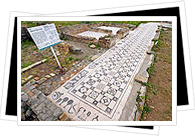 Marbella has a rich history, loaded with interesting details.
Marbella has a rich history, loaded with interesting details.
Archaeological evidence point to the fact the there were inhabitants in Marbella for a number of thousands of years before Christ. These Paleolithic and Neolithic artifacts (objects and human remains) were found on the Sierra Blanca mountain and its surroundings.
After that, Marbella played host to several civilizations that settled in the area, particularly in the region of the Rio Real – the Phoenicians, the Visigoths, Vandals and Byzantines. All these groups left their mark in Marbella by way of the many historical structures – or their remains. Rome also left its mark in Marbella, as can be seen in the Guadalmina Thermal Baths, the Rio Verde Roman Villa and other archeological remains across the city’s Old Town.
But admittedly, it was the Moors which left the largest mark. It is during their time that Marbella (or Marbiliya at that time) became a walled city. The Moors built the Al Kasbah (Alcazaba), a walled city with a castle and a moat. There were only three gates leading into the castle – one that led from Ronda, one from Malaga and one from the sea. Currently, only the castle remains standing, the doors and the moat have long since disappeared.
It was only in 1485 that Marbella became part of Spanish territory. This was when the Catholic Kings claimed Marbella for Spain. This scene is depicted in the engravings found in the Cathedral of Toledo, in the choir area. The Moors handed over the keys to the city into the hands of King Fernando. The town was then given the title “Noble and Loyal City”.
The conquest was the start of radical changes in Marbella. The structure of the city was modified. The former Muslim Medina was torn down to give way to the current main square (the Plaza de los Naranjos – the Orange Square) and a new street (Calle Nueva) that leads to the gate going out to the sea.
Marbella was predominantly an agricultural town. Economic activity was centered on livestock and agriculture. This includes a number of vineyards that produced Marbella’s sweet tasting wines. However, industrialization in Marbella began in earnest during the 19th Century. This heralded the start of the installation of Industrial Estates in Marbella – particularly in La Concepcion and in El Angel. Mining was the major industry then, and the Sierra Blanca Mines was the focal point. Marbella worked hand in hand with Malaga, thus Marbella rose to become the second most important industrial province in the region.
In the mid 1940’s, businessmen started constructing hotels and residential properties in Marbella. This is when the rich and famous started to consider Marbella their very own playground. This period started the rise of Marbella’s tourism industry.
In the 1990’s, Marbella became more and more acknowledged as a “Universal City” and this is where tourism started its boom. Marbella was then equipped with facilities such as municipal offices, cultural centers, new parks and avenues, sports centers, golf courses and the like.
Marbella is now a thriving resort town. It has received numerous awards – both nationally and internationally – for its contribution to tourism and for the city’s cleanliness and security. Indeed, it is a favorite tourist haven, because of its marvelous climate, its beaches and its natural beauty.